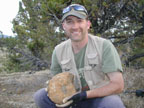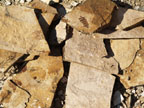Search and Rescue Report |
June, 2007 |
|
The concept: It's the middle of the Cretaceous Period, perhaps 90 million years ago. An aging dinosaur wanders his way to the shoreline of a great ocean, looking for a last meal to survive another day. Not having the strength to continue on, he passes away to the soothing sounds of the low tide waves. Like the cycle of life the tide rises and carries the bloated, lifeless corpse into slow moving waters protected from battling waves. After a short time at sea, the relentless attack of ocean dwelling scavengers eventually send what's left of the floating carcass to settle on the sandy ocean bottom. A quick sedimentary burial followed by millions of years of continental accretion, crustal uplifting, and a little erosion brings the fossilized remains of our dinosaur to light for the first time in 90 million years... somewhere in Wheeler County, Oregon... we think. Hey.. anything is possible, right? A single bone, believed to be from a Hadrosaur, was discovered in the Southwest corner of Oregon a number of years ago. Considering Thomas Condon's theory of the two islands – Mesozoic geologic provinces in Southwest and Northeast Oregon - that accreted to the continent millions of years ago and recent evidence that correlates these two regions, it is not unlikely that more dinosaur evidence could be right around the next outcrop... and we went looking. In June 2007, members of NARG set out for a few days to start the enormous task of finding just one piece of elusive evidence (not to mention an articulated archasaurian). Along for the adventure was the production crew for Oregon Field Guide, a regional science and nature, human interest series on public television… I suppose just in case we found something. Bearing in mind the remains of marine reptiles have already been found in the Hudspeth Formation near Mitchell, the search team focused efforts on accessible areas of the 70 square miles of exposed fossil-fertile land. A few BLM localities were searched along with some private properties after the imperative permission was acquired. Needless to say no dinosaurs were found on the excursion, but ammonites were abundant just about everywhere we explored. On this trip, a complete, eight-inch-diameter Lecontinites was probably the best of King Triton's treasures (a reference to The Little Mermaid for the kids). Being avocational paleontologists by definition suggests we'll have fun, interesting and educational adventures even when we don't find the discovery of the century. It is about the journey after all... and at some point our journey will cross the path of our dinosaur's journey. We just have to keep looking. Trip Participants: Aaron Currier, Bill Sullivan, Jerry Rawdon, Andrew Bland, Garret Romain, Mike Kelly, Greg Kovalchuk, Tim Fisher, Jim Scheirbeck, and Larry Purchase |
| ©2004 NARG - North America Research Group |






